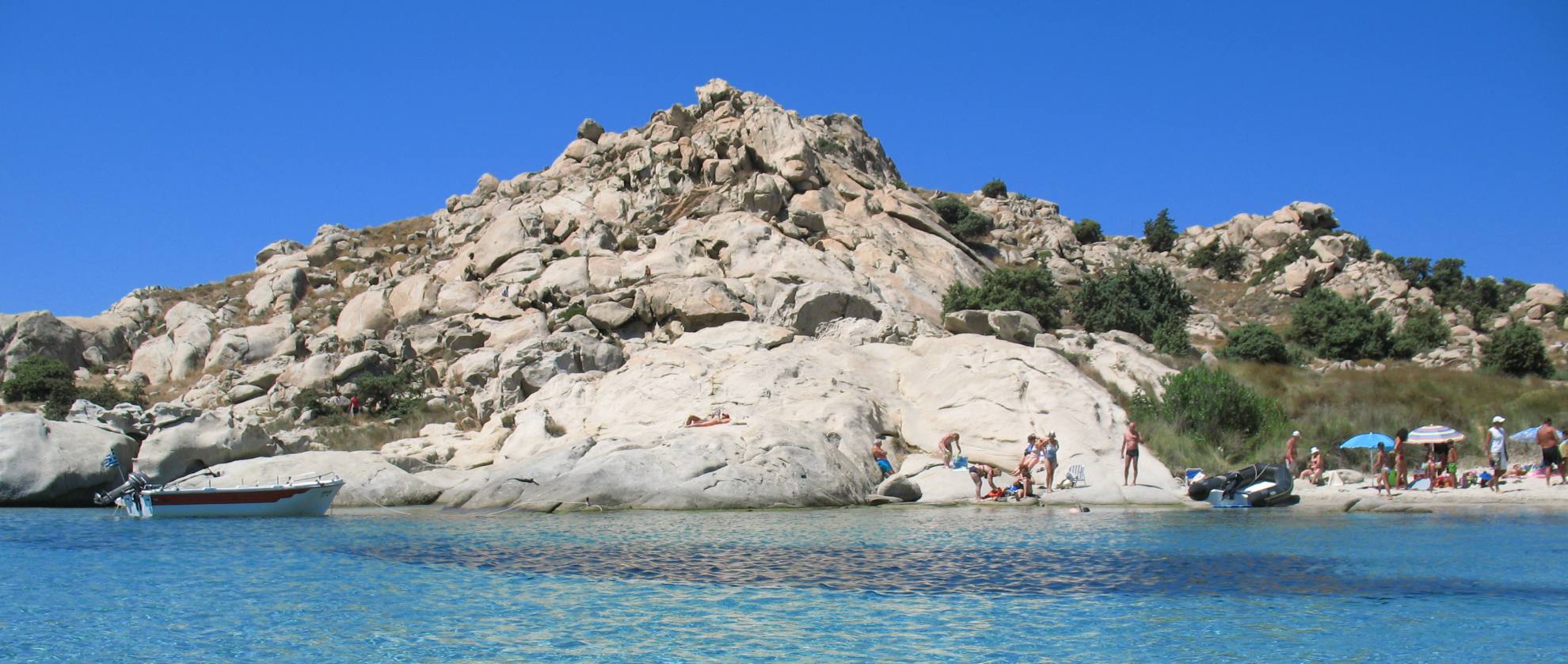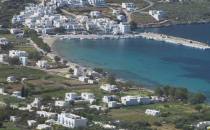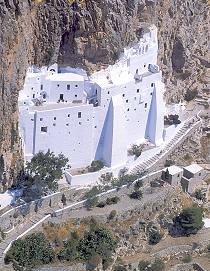AMORGOS - Friendly & Authentic
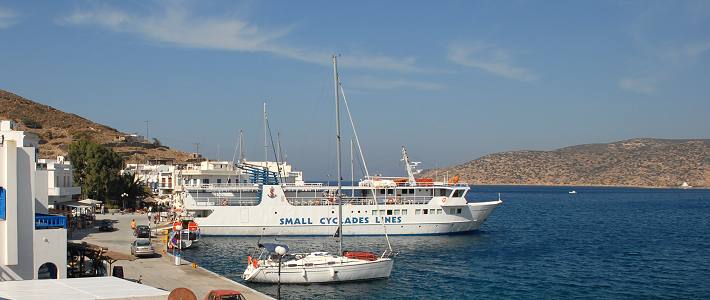
More about amorgos
Amorgos Hotels
Amorgos Photos
Amorgos Photos (North)
Amorgos Photos (South)
Far away, to the east, in the Archipelago rises the islandic ridge of Amorgos, lonely and eerie. Although it lies in the middle of the open sea, its oblong shape, reminiscent of a gigantic snake, literally obscures the horizon to the traveller coming from the west on his way to the Eastern Aegean. It is as if the Cyclades look forward to blocking any sailing beyond their boundary, giving the newcomer the impression that the end of the world must be somewhere near about.
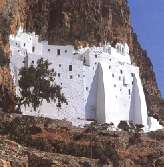 To a perceptive mind, Amorgos remains an immemorial sea crossroads where East meets West, where both are assimilated into high quality composition. The island lies across the waters of the Aegean like a sharp arrow signalling the way to the East.
To a perceptive mind, Amorgos remains an immemorial sea crossroads where East meets West, where both are assimilated into high quality composition. The island lies across the waters of the Aegean like a sharp arrow signalling the way to the East.
Its people likewise have preserved to our days, with clarity and straightforwardness, both in their look and their soul, that which once was called Innocence and Kindness. These qualities have been raised to an enviable standard through the historical experiences of pain, stoicism and the struggle of the Amorgeans to secure their survival.
Amorgos is the Sun and Cliff, Hardship and Smile, Storm and Joviality... It is the land where "God is great" and "God will provide"! From the fea blessed springs parental optimism still gushes forth, the immemorial and unbeatable weapon, the holy acquisition of the Amorgean Soul.
The astonishing Monastery of Hozoviotissa (photo above), the pride of Amorgos, is remarkable and seems been pressed on the cliff 300 meters above the sea. In Hora there is a chapel -Agios Fanourios- which is claimed to be the smallest chapel in Greece, having room for two prayers only.
Amorgos is picturesque with spectacular cliffs, beautiful Hora (capital), with excellent walking.
Amorgos is unspoiled, friendly, with an authentic "Greekness" atmosphere.
-
Getting ThereBy Sea: ferries call at either port, Katapola or Aegiali . Amorgos is connected to Piraeus and Rafina. Island interconnections include Naxos, Koufonisi, Schinoussa and Iraklia, Paros, Syros, Mykonos, Santorini, Milos.
By Air: Amorgos nearest international airport is in Mykonos. You can check Mykonos schedules at www.openseas.gr -
Getting Around
There is frequent bus service between Katapola and Hora (the capital of the island).
Buses are also running between Katapola, Aegiali, Hora, Hozoviotissa Monastery, Agia Anna and Paradisi.
Taxis are also available.
Amorgos Beaches
Agia Anna, pebble beach, with deep blue and crystal clear water
Agios Panteleimon, nice, wide beach
Kalotaritisa, beach with fine sand
Katapola, a couple of grey coarse sand in Ksilokeratidi
Maltezi, beautiful secluded beach
Mourou, nice beach
Touring Amorgos
Amorgos (Hora)
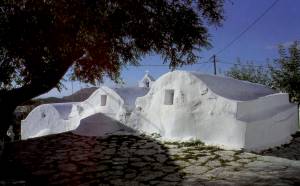 (300 meters altitude) centres around a 13th century Venetian castle (built in 1290) with panoramic view of the whole island.
Forty churches and chapels nestle inside including Agios Fanourios that holds
only two people.
(300 meters altitude) centres around a 13th century Venetian castle (built in 1290) with panoramic view of the whole island.
Forty churches and chapels nestle inside including Agios Fanourios that holds
only two people.
Hora is beautiful, very simple, very Cycladic with narrow streets and alleys, a row of windmills, empty of cars. There are not many tourist living in Hora but there are rooms to rent, as well as taverns, a few bars and arty shops.
Aegiali
is Amorgos' second port. Aegiali is a friendly, picturesque, pleasant little place with
fishing boats inside the rocky ferry quay, a completly different world within Amorgos.
In Aigiali there is the very old Chapel of Panayitsa built on a site of an ancient sanctuary.
There are good sandy beaches and plenty of taverns, mini-markets and tourist shops.
The Aegiali coastline: Fokiotripa is a beautiful sandy refugee-place of seals where a huge rock with a cave protects it from the winter waves. Next is dream like coastline, one small bay after the other: Levrossos, Psili Ammos, Hoklakas. Levrossos is with fruit-trees and gardens, an alluring place with tamarisks and bamboo to separate gardens from the beach.
Arkesini
stands near the site of the ancient city which has extensive tombs, six metres high wall and houses on the cape of Kastri.
Hozoviotissa Monastery
is the home of an icon of the Virgin from palestine. This remarkable Monastery was built in 1088
by mandate of the Byzantine Emperor Alexis Komninos and is a remarkable white structure
which seems to be plastered to the sheer cliff in 300 meters altitude.
Katapola
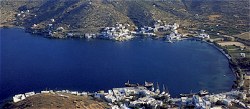 is set at the head of a horseshoe bay and is actually three separate villages: Katapola
in the middle, Rahidi on the ridge of the head of the bay and Ksilokeratidi along the north shore.
Between the settlements lies a peaceful valley. Spread between the low hills dotted with ancient houses and chapels are three strips of fertile plain rich with olive trees, fruit trees and gardens. Yalinas to the North, Marmaros in the centre and Sakkas to the south.
In the town is the famous Katapola Spring with water of excellent quality which flows through an ancient aqueduct to reach the Katapola faucet. The faucet itself is considered to be a monument of Venetian heritage.
is set at the head of a horseshoe bay and is actually three separate villages: Katapola
in the middle, Rahidi on the ridge of the head of the bay and Ksilokeratidi along the north shore.
Between the settlements lies a peaceful valley. Spread between the low hills dotted with ancient houses and chapels are three strips of fertile plain rich with olive trees, fruit trees and gardens. Yalinas to the North, Marmaros in the centre and Sakkas to the south.
In the town is the famous Katapola Spring with water of excellent quality which flows through an ancient aqueduct to reach the Katapola faucet. The faucet itself is considered to be a monument of Venetian heritage.
A paved street leads up the steps to the picturesque higher parts of the town, with orchard full of orange trees, lemon trees and cypresses appearing between the houses with old courtyard doors and shady arches. On the way back from Apano Yitonia (upper neighborhood) is the jewel of the town, Panagia (Our Lady) Katapoliani, one of Amorgos' older Christian monuments. Over the years it has been repeatedly restored but its Cycladic ecclesiastical style of architecture has remained untouched. In the area of Panagia Katapoliani there was a more ancient temple dedicated to Apollo Pythios.
The approach to the first houses of Rachidi is reach in eucalyptus trees. The steps to the village passes from parish Church of Saint George. Many of the houses along the central path are surrounded by sweet-scented flower filled courtyards. At different points along the sea-front narrow tracks lead to Pera Rahidi, or to the depths of Marmaros and Yialinas Valleys. From a distance, very old chapels can be seen on the high ground between the tree-filled dardens and the vineyards. High up at the point where Hora road meets the old stone paved Katapola-Hora road the small Church Taxiarhis (The Archangel) is built in a commanding position over the plain and coast. The building is early Christian with many ancient remains and in that time was a small worship place. Classical sculptures and other remains have been discovered on the nearby hill-slope to the North below Agia Irini Chapel.
The coastal road leads to Ksilokeratidi, where Cycladic colour is splashed everywhere, which has kept its strong nautical style. The fishing village was the central boatyard and moorage for Amorgos' sailing vessels during the last century. Houses where literally built on the sea so that the road could pass and climb higher to the left. The footpath on the other side, with its wide stone steps, climbs to the right, beginning at a small level spot in the centre of the village. Along the small path is the historic Chapel since the early Byzantine era, of Evangelistria, hidden from the sea in a small gully. Its unusual architectural formation is impressive. On Our Lady's Annunciation Day (25th of March), Katapola's large traditional festival is held here. The path to the west leads to the quiet site of Agios (Saint) Panteleimonas, a piece of land slipping smoothly into the sea. The same path leads to the nice secluded beach of Maltezi.
Katapola had already begun its undulating course through history in the early Bronze Age. Throughout the first millenium B.C. the area of today's harbour was the permanent anchorage of Minoan. By the time of the Hellenistic and, chiefly the Roman eras the harbour had developed considerably. This is shown by the abudance of relics (sculptures, inscriptions, mosaic floors, foundation of temples, Roman installations and tombs, early Christian Churches and so on.)
A 40 minutes walk from Katapola up to the hill leads to the ancient city of Minoan with ruins of a gymnasium, stadium and a temple of Apollo. The city is visible from the sea, split like an amphitheatre down the south-eastern slopes of Moundoulia.
The various needs of the visitor are catered for by hotels, rooms-to-let, a camp site, restaurants, taverns, tourist shops and traditional stores, bakeries and mini markets.
Langada
is a very beautiful village, 2.5 Km from Aigiali. A picturesque stone paved mule track also leads here. It takes 30-40 minutes to climb up the slope with the track passing through pretty olive groves.
As the track nears the edge of the village, the huge Machos mountain mass rises above us to the right. It is an extension of the southern Krikellos range.
Nestling on a ledge under an overhang, is the small Agia Triada (Holy Trinity) Church, reminding the position and the appearance of Hozoviotissa.
It appears to have built during the years of piracy when it would have been used as an occasional hiding place for Aegiali inhabitants.
Langada divides up its neighborhoods on the crest of the hill, Kato Yitonia (Lower Neighborhood), Vorina (Northern Quarter), Fanos (Chimney), Loza. Narrow streets often covered with typical Cycladic arches, connect the more distant parts of the village with the main stepped street which like a back-bone cuts through the village from east to west. Between Kato Yitonia and Loza the visitor can find spotless rooms and dine on specialities of the local cuisine. A series of stony paths leads from Loza or from Kato Yitonia towards dream-like rural spots: to the Church of Panagia Epanohoriani, to Dri, and Agios (Saint) Panteleimonas, to the high Machos mill area, to Araklos ravine and even to the furthest rocky areas of Krikellos.
Close to Langada is Tholaria surrounded by Roman tomb sites. The village, built in simple Cycladic style, views over Aegiali Bay. In the central square the large (for the size of the village) church dedicated to the Anargiri Saints (Cosmas and Damian) is surrounded by cafe and a small cake shop.
Potamos
A straight uphill road from Aegiali leads to Potamos village which looks like a balcony to the Aegean Sea. At the entrance to the village, a deep gorge can be noticed which loses itself behind the high and rocky mountains of Krikellos.
The village is divided into two parts Pano and Kato Potamos, both very pretty.
In Kato (Lower) Potamos the parish Church of Analipsis (Ascension) is an imposing presence among the steep streets. A large festival is held here on Ascension Day when people from Potamos return to their village to feel again breeze and to sign again the old Aegialean verses.
Pano (Upper) Potamos seems to be completely untouched by the "materialistic" modern world. The people here have a "pure" cheerful disposition with a sweetness in their smile. On their lips are always best wishes for every passer-by. The narrow streets and the spotless white corners speak for themselves.
Useful Info
Port Authority (Katapola): 22850 71259
Distance from Piraeus: 134 NM
Municipality: 22853 60200
Police (Katapola): 22850 71210
Police (Aegiali): 22850 73320
Medical Centre (Katapola): 22850 71805
